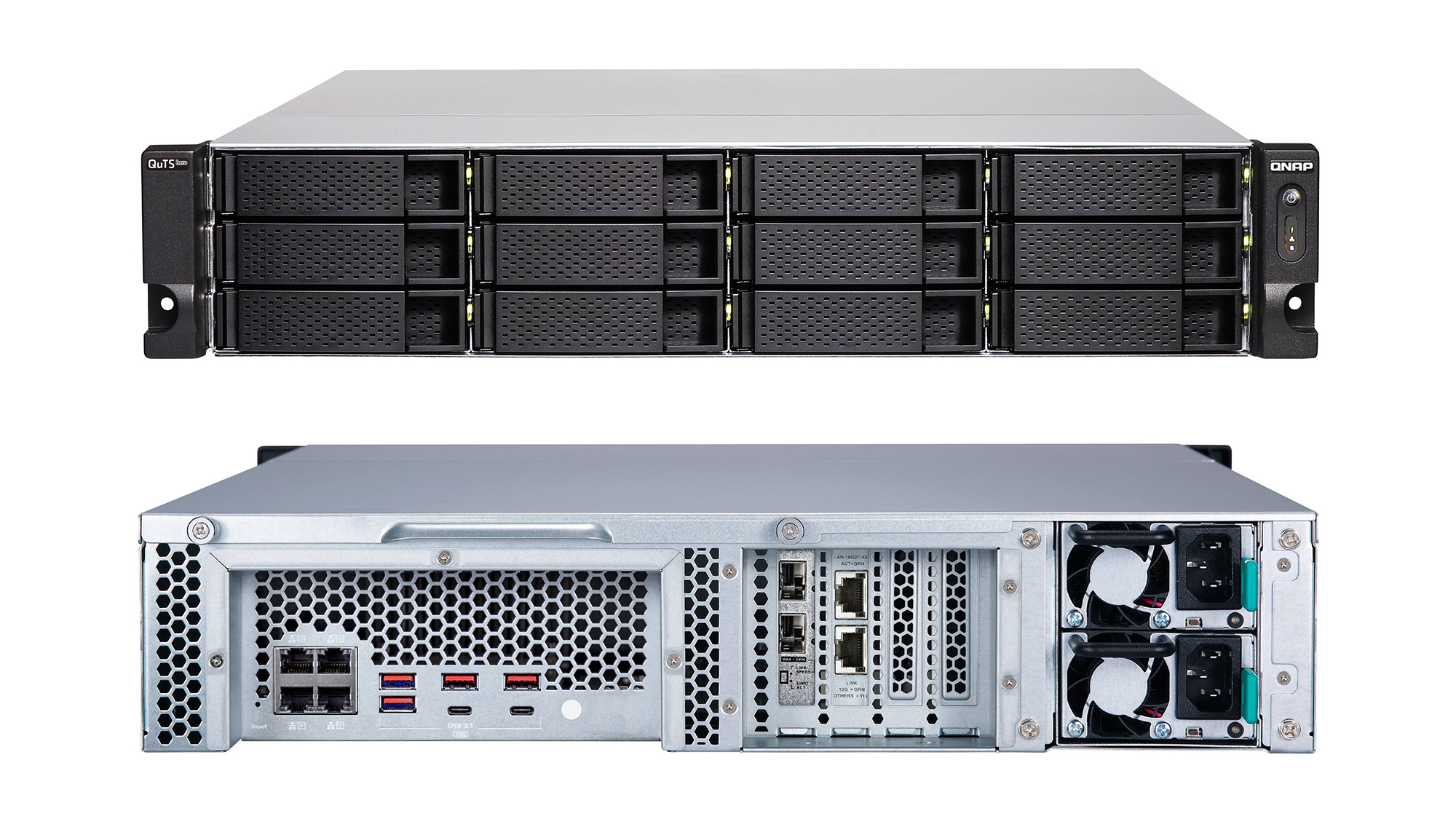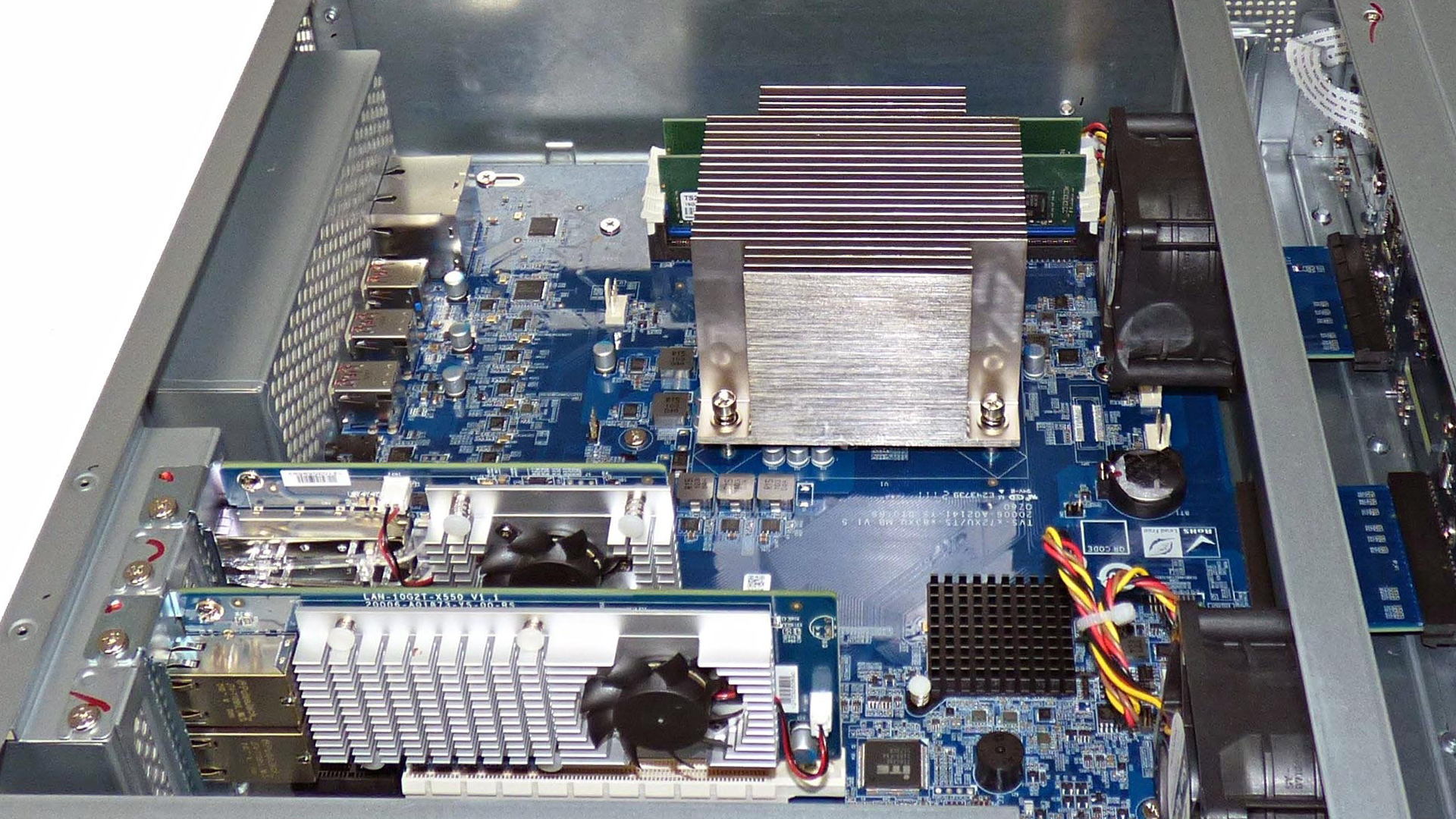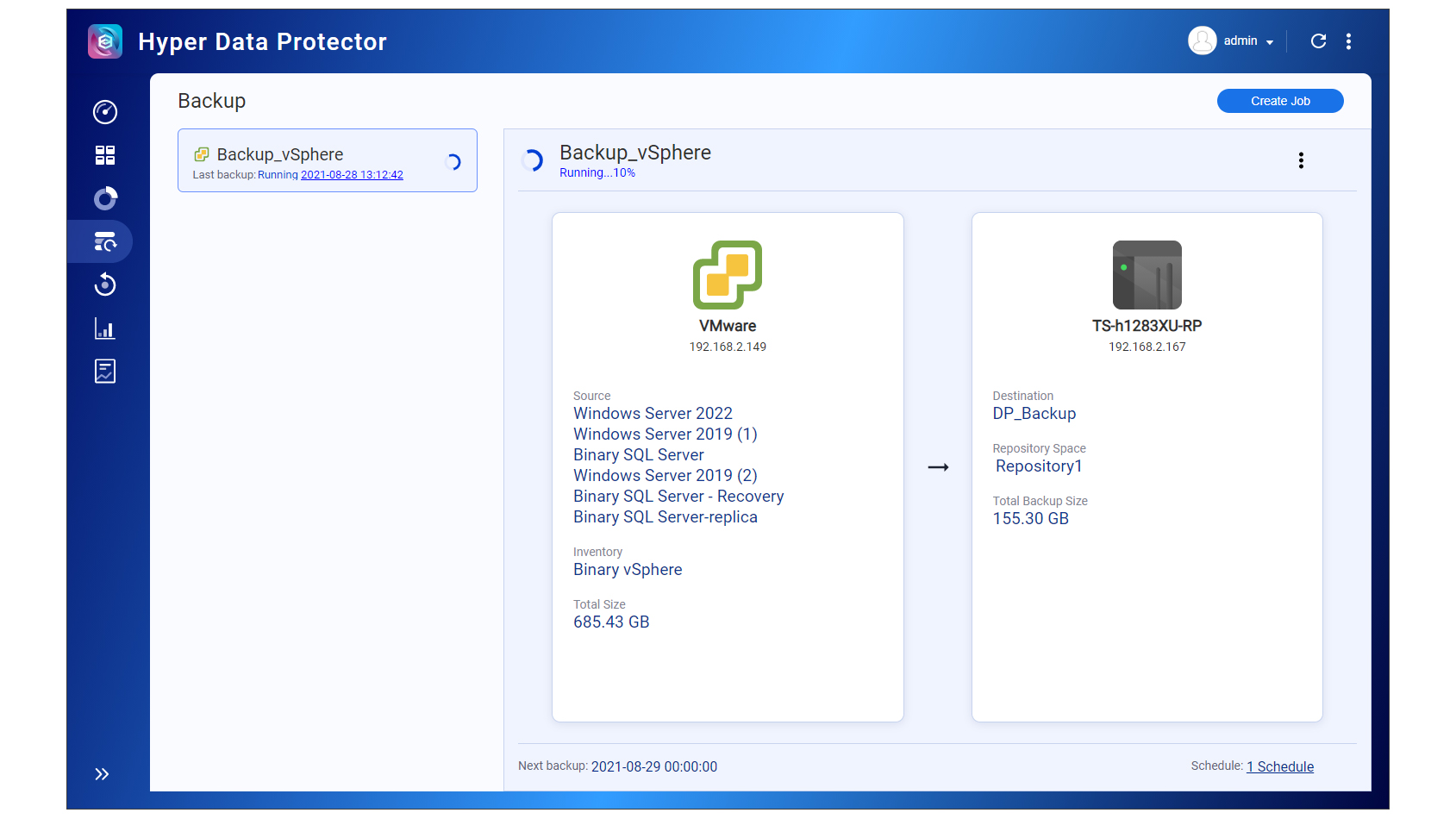Qnap TS-h1283XU-RP review: Well-endowed NAS storage
A versatile storage appliance with Xeon E-2200 power and heaps of 10GbE ports


-
+
Choice of OSes
-
+
Quad 10GbE ports,
-
+
Xeon E CPU
-
+
Great 10GbE performance
-
+
Enterprise data protection features
-
+
High expansion potential

Qnap was the first vendor to equip its NAS appliances with Intel’s Xeon E server-grade CPUs and it now brings this processing power to its enterprise-class QuTS hero-powered rack models. The TS-hx83XU series offers a choice of three drive capacities ranging from 12 to 24 bays, and first of these is the entry-level TS-h1283XU-RP.
This 2U 12-bay appliance has plenty of power on tap, with a speedy 3.4GHz six-core Xeon E-2236 in the driving seat partnered by 32GB of ECC DDR4 memory expandable to 128GB. Network port permutations are excellent as the appliance includes quad embedded Gigabit and two dual-port PCI-E expansion cards providing a choice of 10GbE RJ-45 and SFP+ fibre ports.
The TS-h1283XU-RP is massively expandable - even with the two 10GbE cards in residence, it still has two more free PCI-E slots. Along with a choice of 10GbE, 25GbE and 40GbE network cards plus fibre channel adapters, it accepts Qnap’s multi-port SAS3 expansion cards allowing up to sixteen 16-bay TL-R1620Sep-RP disk shelves to be daisy-chained in fault tolerant links.
Qnap TS-h1283XU-RP review: QuTS features
Qnap’s QuTS hero is a 128-bit ZFS-based operating system which delivers a range of valuable enterprise-class data integrity and protection features. End-to-end checksums offer transparent self-healing of data corruption, ZFS copy-on-write provides fast, near-unlimited snapshots for NAS shares and iSCSI LUNs, and it introduces triple mirroring. This stores identical copies of data on three drives and triple parity RAID (RAID-TP) to protect against up to three drive failures.
NAS share data can be protected from unauthorized deletion or modification by applying one of two WORM (write once read many) policies, and QuTS hero can also make big storage savings with compression and in-line deduplication. However, there’s a good reason why the TS-h1283XU-RP comes with a base 32GB of memory: the QuTS deduplication requires a minimum of 16GB, the 10GbE ports need at least 32GB to get the best performance out of them and up to 1TB SSD cache sizes are supported.

On the other hand, the appliance’s browser-based quick start wizard offers a choice between QuTS hero and Qnap’s standard QTS OS, if you wish. This is less demanding for memory but doesn’t offer the same level of data protection features as QuTS and only supports EXT4 volumes.
Qnap TS-h1283XU-RP review: 10GbE performance
Qnap recommends SSDs for the best system pool performance, so we loaded QuTS on dual mirrored 960GB Micron SFF SSDs. For data pool duties, we chose six Toshiba 18TB MG09 SATA HDDs and created a big 79TB RAID5 storage pool.
With a NAS share mapped over a 10GbE fibre link to a Dell EMC PowerEdge T640 tower running Windows Server 2019, we saw Iometer report great sequential read and write rates of 9.3Gbits/sec and 9.2Gbits/sec. Real world performance was equally good with drag and drop copies of a 25GB test file returning read and write rates of 7.7Gbits/sec and 8Gbits/sec, while securing a 22.4GB folder with 10,500 small files averaged a speedy 2.5Gbits/sec.
IP SAN performance is up there too, with a 1TB iSCSI target returning top Iometer sequential read and write rates of 9.3Gbits/sec and 9.2Gbits/sec. We then created a dual 10GbE MPIO link to the target and recorded average Iometer read and write rates of 18.5Gbits/sec and 17.4Gbits/sec.
QuTS scores over QTS for its more efficient handling of random operations as its ARC (adaptive read cache) and ZIL (ZFS intent log) features negate the need for SSD caches. We confirmed this with our dual MPIO iSCSI target, which returned random read and write speeds of 18.4Gbits/sec and 17.1Gbits/sec.
Qnap TS-h1283XU-RP review: Data protection

The QuTS web interface is virtually identical to Qnap’s standard QTS version and presents a shallow learning curve. You’ll come across many of its data protection features when creating NAS shares as the wizard offers options for thick or thin provisioning, encryption, compression, deduplication and WORM policies.
For WORM, you can set a retention period in days, months or years, while the Enterprise policy allows a protected folder to be deleted but stops anything in it from being individually modified or removed. The Compliance policy is tougher, as the only way to delete the folder is to remove the parent storage pool.
Snapshot creation procedures are the same as for QTS; you choose a folder or iSCSI LUN, apply a schedule and decide how many to retain. Smart snapshots save space as they will only occur if the data has changed since the last one and data can be swiftly restored using the File Station 5 app to browse NAS snapshots.
Qnap TS-h1283XU-RP review: App choices
App support is excellent as we checked the App Center and counted 113 packages available for the TS-h1283XU-RP. All key backup and file syncing apps are present and include Hybrid Backup Sync (HBS) 3, Qsync Central and HybridMount, plus Hyper Data Protector which protects VMware and Hyper-V virtualized environments.
Boxafe provides NAS-based backup services for G Suite and Office 365 cloud accounts, while the Malware Remover keeps your on-appliance data safe. The appliance can also host virtual machines via the Container Station, Ubuntu Linux Station and Virtualization Station apps.

Snapshots can be replicated to other QuTS appliances for additional protection too. The freshly released SnapSync service is accessed from the Storage & Snapshots app and synchronises snapshots to remote QuTS appliances, either according to a set schedule or in real time.
Qnap TS-h1283XU-RP review: Verdict
Qnap’s TS-h1283XU-RP has what it takes to satisfy businesses that want a solid combination of storage performance, data protection features and expansion potential. The choice of two OSes adds a lot of flexibility and although the asking price for a diskless unit may seem high, bear in mind this includes a fast Xeon E-2236 CPU, 32GB of memory and a quartet of 10GbE data ports.
Qnap TS-h1283XU-RP specifications
| Chassis | 2U rack chassis |
| CPU | 3.4GHz six-core Intel Xeon E-2236 |
| Memory | 32GB ECC DDR4 UDIMM (max 128GB) |
| Storage | 12 x SATA LFF/SFF |
| RAID | RAID0, 1, 5, 6, 10, 50, 60, Triple Parity, Triple Mirror |
| Expansion | 1 x PCI-E Gen 2, 3 x PCI-E Gen 3 slots (2 free) |
| Network | 4 x Gigabit, 2 x 10GbE RJ-45, 2 x 10GbE SFP+ |
| Other ports | 2 x Type-C USB 3.2, 4 x Type-A USB 3.2 |
| Power | 2 x hot-plug 500W PSUs |
| Management | Web browser |
| Warranty | 3 year limited |
Get the ITPro daily newsletter
Sign up today and you will receive a free copy of our Future Focus 2025 report - the leading guidance on AI, cybersecurity and other IT challenges as per 700+ senior executives
Dave is an IT consultant and freelance journalist specialising in hands-on reviews of computer networking products covering all market sectors from small businesses to enterprises. Founder of Binary Testing Ltd – the UK’s premier independent network testing laboratory - Dave has over 45 years of experience in the IT industry.
Dave has produced many thousands of in-depth business networking product reviews from his lab which have been reproduced globally. Writing for ITPro and its sister title, PC Pro, he covers all areas of business IT infrastructure, including servers, storage, network security, data protection, cloud, infrastructure and services.
-
 Third time lucky? Microsoft finally begins roll-out of controversial Recall feature
Third time lucky? Microsoft finally begins roll-out of controversial Recall featureNews The Windows Recall feature has been plagued by setbacks and backlash from security professionals
By Emma Woollacott Published
-
 The UK government wants quantum technology out of the lab and in the hands of enterprises
The UK government wants quantum technology out of the lab and in the hands of enterprisesNews The UK government has unveiled plans to invest £121 million in quantum computing projects in an effort to drive real-world applications and adoption rates.
By Emma Woollacott Published
-
 Businesses are taking their eye off the ball with vulnerability patching
Businesses are taking their eye off the ball with vulnerability patchingNews Security leaders are overconfident in their organization’s security posture while allowing vulnerability patching to fall by the wayside.
By Jane McCallion Published